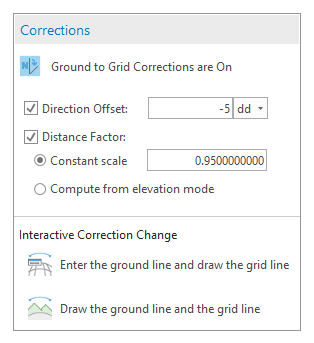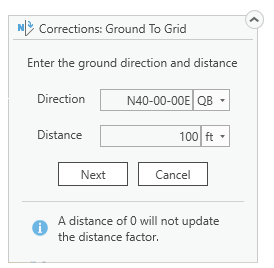Ground to grid correction is a drawing mode that converts COGO ground measurements to grid measurements defined by the coordinate system of your feature data. It is available on the Edit tab in the Correction group, and on the status bar located at the bottom of an active map.
Ground to grid correction is applied automatically when you turn ground to grid on and use ground to grid aware tools. An offset angle is applied to typed direction values, and a distance factor multiplies typed distances.
You can configure ground to grid correction by specifying values or interactively by sketching a known ground line in a map.
Note:
Ground to Grid is not available with 3D scenes.
Enable COGO for your line feature
COGO enabling a feature adds attribute fields that the store COGO measurements independent of the geometry attributes. You can use ground to grid correction without enabling COGO fields, but the survey dimensions you type into tools will not be stored with the feature.
- On the Analysis tab, in the Geoprocessing group, click Tools.
The Geoprocessing pane appears.
- In the Geoprocessing pane, in the search box, type COGO and press Enter.
- Click Enable COGO.
The tool appears in the pane.
- Click the Input Line Features drop-down arrow and select the line feature layer on which you are creating parcel features.
- Click Run
 .
.
Turn Ground to Grid on
Turn Ground to Grid correction on to apply the current offset angle and distance factor the the values you type into ground to grid aware tools.
Tip:
Confirm your Ground to correction settings before creating features. Changing correction settings for features from the same survey document can introduce slight differences in the geometries you create.
- On the Edit tab, in the Corrections group, click Ground To Grid.
You can also turn this setting on or off on the status bar at the bottom of the active map.
When a feature construction tool is active, the on-screen display appears in the upper right corner of the map showing the enabled correction settings.

- To turn Ground to Grid off, click Ground To Grid again.
Set the direction offset
The direction parameter applies the specified offset value to the ground bearing values you type into ground to grid aware tools. A positive angle rotates your values counterclockwise. A negative angle rotates them clockwise using the default angular units set for the project.
For example, when a line feature class is COGO enabled, setting a direction offset of -5° and typing a ground direction of N40°E writes N40°E to the COGO direction field and creates or constrains the new segment at N45°E.
For steps to set the default project units, see Add units of measure for editing.
- On the Edit tab, in the Corrections group, click the Ground To Grid drop-down arrow.
You can also show the settings on the status bar at the bottom of the active map.
The Corrections dialog box appears.

- Click the units drop-down arrow and choose a unit of measure.
- In the Direction Offset text box, type the offset angle that's correct for the selected units.
- Check Direction Offset to apply the offset angle when you turn ground to grid correction on.
- Move the pointer away from the dialog box.
The dialog box closes.
Set the distance factor
The distance factor is applied to distance values you type into editing tools. You can set a constant ground to grid factor or compute a combined scale factor using the active surface elevation mode and current coordinate system.
For example, when a line feature class is COGO enabled, setting a distance factor of 0.95 and typing a ground distance of 100 feet writes 100 feet to the COGO distance field and creates or constrains the new segment at 95 feet long.
- On the Edit tab, in the Corrections group, click the Ground To Grid drop-down arrow.
You can also show the settings on the status bar at the bottom of the active map.
The Corrections dialog box appears.

- In the Constant scale text box, type a scale factor.
- Choose how the distance factor is computed:
- Constant scale—Scales all distances by the scale factor specified in the text box.
- Compute from elevation mode—Computes a combined scale factor using the active elevation surface, and the coordinate system for the active map.
Note:
This setting uses z-values generated by the current elevation mode. When you create new features and move the pointer, the scale factor updates dynamically on the corrections display in the upper right corner of the map.
On the Edit tab, in the Elevation group, you can set the elevation mode to a constant z-value or set it by clicking an active surface. To learn more, see Specify an elevation for 3D features.
- Check Distance Factor to apply the distance factor when you turn Ground to Grid on.
- Move the pointer away from the dialog box.
The dialog box closes.
Type ground line values and draw a grid line
Typing COGO ground line values and drawing a grid line on the map computes the direction offset angle and distance factor and updates the correction settings. The correction values are computed by comparing the grid distance and grid direction of a line with the same line's COGO value equivalents.
For example, typing a ground direction of N40°E and drawing a grid line at N45°E sets a direction offset of -5°. Typing a ground distance of 100 feet and drawing a grid line at 95 feet long sets a distance factor of 0.95.
- On the Edit tab, in the Corrections group, click the Ground To Grid drop-down arrow.
You can also show the settings on the status bar at the bottom of the active map.
The Corrections dialog box appears.

- Click Enter the ground line and draw the grid line.
The Ground Line dialog box appears.

- Click the units drop-down arrow and choose a unit of measure.
- In the Direction text box, type the ground direction.
- In the Distance text box, do one of the following:
- Type the ground distance, for example, 100 feet.
- Do not type a value and accept the default value of 0.00.
Note:
Typing or leaving the value as zero (0) preserves the current constant scale setting and updates only the direction offset.
- Click Next.
The on-screen display appears in the upper right corner of the map prompting you to click the start point.

- Click the map and create the start point of the sample grid line.
The on-screen display appears in the upper right corner of the map prompting you to click the endpoint.

- Move the pointer and click the map again to create the endpoint.
The ground to grid correction values update.
Draw a ground line and a grid line
Interactively sketching the ground and grid lines computes the correction values by comparing the grid distance of a line with its COGO value equivalents.
For example, drawing a ground line at N40°E and a grid line at N45°E sets a direction offset of -5°. Drawing a ground line of 100 feet and a grid line at 95 feet long sets a distance factor of 0.95.
- On the Edit tab, in the Corrections group, click the Ground To Grid drop-down arrow.
You can also show the settings on the status bar at the bottom of the active map.
The Corrections dialog box appears.

- Click Draw the ground line and draw the grid line.
The on-screen display appears in the upper right corner of the map prompting you to click the start point.

- Click the map and create the start point of the sample ground line.
The on-screen display appears in the upper right corner of the map prompting you to click the endpoint.

- Move the pointer and click the map again to create the endpoint.
The on-screen display appears in the upper right corner of the map prompting you to click the start point.

- Click the map and create the start point of the sample grid line.
The on-screen display appears in the upper right corner of the map prompting you to click the endpoint.

- Move the pointer and click the map again to create the endpoint.
The ground to grid correction values update.